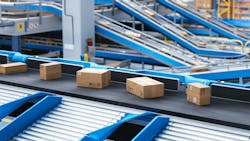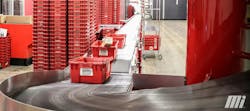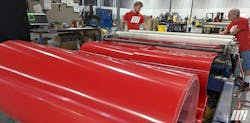How to select the right belt for package and handling applications
Key takeaways
- The right conveyor belt boosts throughput, prevents downtime, and safeguards product quality.
- Belt choice must match package weight, shape, and material to reduce damage and inefficiency.
- Durable, low-energy belts lower total cost of ownership and support sustainability goals.
In the world of modern logistics, packaging, and material handling, choosing the right conveyor belt can make all the difference between hitting your KPIs or facing unplanned downtime. A key but often-overlooked component in achieving these operational goals is the conveyor belt, which is vital in streamlining production, increasing throughput and ensuring product integrity.
Selecting the right conveyor belt for a specific package and handling application may seem straightforward. However, it actually requires a clear understanding of your operational needs, the characteristics of the products transported, and the availability of belt types and materials. A misstep can lead to excessive downtime, product damage, increased maintenance costs and energy use, and overall inefficiency. To avoid such setbacks, businesses must take a strategic and informed approach to belt selection.
Defining conveyor belt requirements for industrial applications
The starting point for choosing the right conveyor belt is understanding your application’s specific demands. Not all package-handling systems are created equal. Some operations deal with fragile, lightweight parcels, while others are tasked with moving heavy, irregularly shaped loads. Some systems are designed for high-speed sorting, while others require precise product placement or stop-and-go motions that can cause extreme stress on the conveyor belt.
Each option imposes different demands on the belt. For instance, belts in a high-speed sortation system must offer excellent tracking, wear resistance, and minimal friction, while belts used in incline or decline conveyors require a high-friction surface or cleats to prevent packages from slipping.
Matching conveyor belts to product size, weight, and packaging materials
Once the operational needs are defined, the next step is to review the nature of the products being conveyed. Understanding their size, weight, shape, and bottom-surface texture is critical. Lightweight items often require a low-tension belt to reduce power consumption and mechanical stress on the conveyor. Conversely, heavy packages demand a more robust belt with high tensile strength and tear resistance.
Package size affects the minimum pulley diameter and belt flexibility requirements. Sharp or abrasive package edges require tougher belt covers to withstand wear and impact without fraying or delaminating. Meanwhile, products with uneven bottoms or rigid protrusions might need a belt with a more rigid structure or a customized cover profile.
The type of packaging material is another factor that influences belt selection. Packages made from plastic, metal, cardboard, or shrink wrap all interact differently with conveyor belts. For example, slick shrink-wrapped parcels are prone to sliding, especially on inclines or in accumulation zones. In such cases, a belt with a higher coefficient of friction or a patterned surface may be necessary to keep products securely in place. On the other hand, cardboard boxes may gather dust or debris, which can reduce traction or build up in the system. This calls for belts that are resistant to contamination buildup or have easy-to-clean surfaces.
Adapting conveyor belts to harsh manufacturing and warehouse environments
Environmental conditions are equally important and must not be underestimated. Factors such as temperature, humidity, and exposure to oils, grease, moisture, or chemicals can drastically affect a belt’s performance and longevity. In cold storage facilities, for example, belts must remain flexible and functional at subzero temperatures. In hot environments, especially those involving heat shrink tunnels or ovens, belts must withstand elevated temperatures without warping or degrading. Facilities exposed to water or high humidity levels require belts with hydrolysis-resistant materials and microbial resistance to prevent mold or mildew growth. For environments exposed to oils or solvents, chemically resistant belt materials like polyurethane or nitrile may be necessary to avoid swelling or deterioration.
In highly automated facilities or those that use robotic integration, the interaction between the belt and other equipment becomes even more critical. Belts in these environments must provide consistent product orientation and predictable movement to allow for precise robotic pick-and-place operations. Any variation in belt surface texture, speed, or flatness can result in misalignment or missed cycles. Belt tracking, stiffness, and minimal stretch are top priorities here. Furthermore, static buildup can interfere with sensors or create safety hazards, which means antistatic belts may be necessary.
Comparing conveyor belt materials: Strength, durability, and performance factors
The belt construction, comprising both the carcass and cover materials, must be carefully chosen to match operational requirements. The carcass, or inner layer, provides strength and flexibility and is usually made from fabrics like polyester, nylon, or aramid. Polyester is popular for its low stretch and good dimensional stability, while nylon offers higher impact resistance and flexibility.
The cover layer, the belt’s outermost surface and the one in contact with packages, can be made from materials such as PVC, urethane, silicone, or rubber. Each has its pros and cons. PVC is cost-effective and versatile but may crack from extreme cold. Urethane offers better resistance to abrasion and chemicals.
Surface texture also plays a key role in belt performance. Smooth belts are ideal for accumulation and easy product transfer, while textured or patterned belts improve grip and are better suited for inclines or declines (see Figure 1). Some belts feature coatings or profiles specifically designed for unique applications, such as longitudinal ribs to channel liquids away or perforations to allow airflow for drying or cooling. If your conveyor requires accumulation zones, then belt surface tension and release characteristics must be finely tuned to ensure smooth movement without product scuffing or jamming.
As industries evolve, sustainability is becoming a higher priority in material handling systems. Conveyor belts made from recyclable materials, or those offering long service life and low energy consumption, are gaining traction. Certain lightweight belts reduce motor loads, while belts designed for low-friction operation help minimize environmental impact. Some manufacturers now offer belts with ecologically friendly components.
Aligning conveyor system design with belt selection for maximum efficiency
Conveyor system design factors must also be considered during belt selection. These include pulley diameter, belt length and width, the number of drives and idlers, belt speed, and the type of take-up system (see Figure 2). Smaller pulleys require more flexible belts, while wider belts must maintain lateral stiffness to prevent sagging or edge curling. Belt tension must be matched with the drive system to avoid slippage or excessive wear.
For curved conveyors or systems with multiple transition points, the belt must exhibit excellent tracking and sidewall integrity to stay aligned and centered. In high-speed applications, centrifugal forces become important variables that require precision-engineered materials and configurations.
Reducing total cost of ownership through smarter conveyor belt Investments
Maintenance requirements and total cost of ownership (TCO) are unfortunately often overlooked during the belt selection process, but they are critical to long-term success. A low-cost belt may initially seem appealing but can incur higher operational costs due to frequent replacements, increased downtime, or higher energy usage. Conversely, investing in a more durable, easy-to-clean belt often yields a lower TCO over time.
Belt changeover time, availability of replacement parts, and ease of sanitation and compatibility with existing conveyor infrastructure should all factor into the decision-making process. It's wise to work with a trusted belting supplier or system integrator who understands your industry’s nuances and can offer customized solutions or modifications to standard belts.
Ultimately, selecting the correct conveyor belt for a package and handling application is not a one-size-fits-all decision. It requires a comprehensive assessment of the conveyed products, operating environment, system design, and performance expectations. Making the best choice involves collaboration between operations managers, engineers, maintenance teams, and trusted suppliers. With careful consideration and expert guidance, the right conveyor belt can enhance system performance, protect components, reduce operational costs, and contribute to a smoother, safer, more reliable packaging and handling process.
About the Author
Kevin McCarthy
Kevin McCarthy is the Senior Product Manager of Lightweight Belting at Motion Conveyance Solutions. He focuses on lightweight-belt new product development, training, customer support and vendor partnerships. He also is a NIBA committee member. For more information, visit MiConveyanceSolutions.com.


